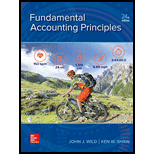
Concept explainers
Concept Introduction:
Current assets are Assets of the business that are realizable or convertible to cash within a period of one year or less.
Examples of Current assets include Stocks and Inventories, Debtors and Investments made for a period of less than one year.
Inventories refer to the closing balance of stock of raw materials, work in progress and finished goods of a company at the end of a particular reporting period.
Requirement 1:
Inventories reported by Apple on September 30, 2017 and September 24,2016.
Concept Introduction:
Current assets are Assets of the business that are realizable or convertible to cash within a period of one year or less.
Examples of Current assets include Stocks and Inventories, Debtors and Investments made for a period of less than one year.
Inventories refer to the closing balance of stock of raw materials, work in progress and finished goods of a company at the end of a particular reporting period.
Requirement 2:
Inventories reported by Apple on September 30, 2017 and September 24,2016 as a percentage of Current Assets.
Concept Introduction:
Current assets are Assets of the business that are realizable or convertible to cash within a period of one year or less.
Examples of Current assets include Stocks and Inventories, Debtors and Investments made for a period of less than one year.
Inventories refer to the closing balance of stock of raw materials, work in progress and finished goods of a company at the end of a particular reporting period.
Requirement 3:
If Apple would prefer to have inventories as a lower or higher percentage of current assets.
Concept Introduction:
Ratio Analysis:
Ratio analysis is a study of several key metrics of a company based on the data presented in its' financial statements with an objective to evaluate the financial health of a company.
It is essential for investors, stakeholders, government bodies etc. to evaluate the key metrics of an entity in order to ensure that the company fulfills the going concern principle and displays financial stability.
Inventory turnover − A measure of the relation between the turnover and inventory measured in number of times.
It seeks to measure the relation of the inventory rolled over in proportion to the total turnover and is an indicator of how much of the inventory is fast moving in relation to the total turnover.
Days Sale in Inventory − A measure of the total outstanding collections for credit sales in terms of inventory.
It is calculated to understand how many days sales in terms of inventory are available to the company.
Requirement 4:
Inventory Turnover Ratio and Days Sale in Inventory as on 30 September, 2017
Trending nowThis is a popular solution!

Chapter 6 Solutions
Fundamental Accounting Principles
- Which basis of accounting recognizes revenues and expenses when cash is exchanged?A. AccrualB. Modified AccrualC. Cash BasisD. Matchingneed helparrow_forwardWhich basis of accounting recognizes revenues and expenses when cash is exchanged?A. AccrualB. Modified AccrualC. Cash BasisD. Matchingarrow_forward9. Which of the following best describes deferred revenue?A. Cash received before revenue is earnedB. Cash paid after expense is incurredC. Revenue earned but not yet receivedD. Expense incurred but not paidarrow_forward
- Need help. 2. What does a classified balance sheet do that an unclassified one does not?A. Uses the cash basis of accountingB. Categorizes assets and liabilities into current and long-termC. Shows only owner’s equityD. Omits depreciationarrow_forwardDont use AI 2. What does a classified balance sheet do that an unclassified one does not?A. Uses the cash basis of accountingB. Categorizes assets and liabilities into current and long-termC. Shows only owner’s equityD. Omits depreciationarrow_forward2. What does a classified balance sheet do that an unclassified one does not?A. Uses the cash basis of accountingB. Categorizes assets and liabilities into current and long-termC. Shows only owner’s equityD. Omits depreciationarrow_forward
- No chatgpt What is the effect of a debit to an expense account?A. Decreases expensesB. Increases equityC. Increases expensesD. Decreases assetsarrow_forwardI need help 10. What is the effect of a debit to an expense account?A. Decreases expensesB. Increases equityC. Increases expensesD. Decreases assetsarrow_forwardWhat is the effect of a debit to an expense account?A. Decreases expensesB. Increases equityC. Increases expensesD. Decreases assetsneed answerarrow_forward
- dont use ai What is the effect of a debit to an expense account?A. Decreases expensesB. Increases equityC. Increases expensesD. Decreases assetsarrow_forwardFill in the attached balance sheet with the data provided on the SEC for years 2020, 2021 and 22 NIKE, INC BALANCE SHEET Financial Statements 2020 2021 2022 Assets Current Assets Cash and Cash Equivalents [insert value] [insert value] [insert value] Accounts Receivable Net [insert value] [insert value] [insert value] Inventory [insert value] [insert value] [insert value] Other Current Assets [insert value] [insert value] [insert value] Total Current Assets $ - $ - $ - Non-Current Assets Property, Plant and Equipment Net [insert value] [insert value] [insert value] Intangibles [insert value] [insert value] [insert value] Other Assets [insert value] [insert value] [insert value] Total Non-Current/Fixed Assets $ - $…arrow_forwardWhat is the effect of a debit to an expense account?A. Decreases expensesB. Increases equityC. Increases expensesD. Decreases assets helparrow_forward

 AccountingAccountingISBN:9781337272094Author:WARREN, Carl S., Reeve, James M., Duchac, Jonathan E.Publisher:Cengage Learning,
AccountingAccountingISBN:9781337272094Author:WARREN, Carl S., Reeve, James M., Duchac, Jonathan E.Publisher:Cengage Learning, Accounting Information SystemsAccountingISBN:9781337619202Author:Hall, James A.Publisher:Cengage Learning,
Accounting Information SystemsAccountingISBN:9781337619202Author:Hall, James A.Publisher:Cengage Learning, Horngren's Cost Accounting: A Managerial Emphasis...AccountingISBN:9780134475585Author:Srikant M. Datar, Madhav V. RajanPublisher:PEARSON
Horngren's Cost Accounting: A Managerial Emphasis...AccountingISBN:9780134475585Author:Srikant M. Datar, Madhav V. RajanPublisher:PEARSON Intermediate AccountingAccountingISBN:9781259722660Author:J. David Spiceland, Mark W. Nelson, Wayne M ThomasPublisher:McGraw-Hill Education
Intermediate AccountingAccountingISBN:9781259722660Author:J. David Spiceland, Mark W. Nelson, Wayne M ThomasPublisher:McGraw-Hill Education Financial and Managerial AccountingAccountingISBN:9781259726705Author:John J Wild, Ken W. Shaw, Barbara Chiappetta Fundamental Accounting PrinciplesPublisher:McGraw-Hill Education
Financial and Managerial AccountingAccountingISBN:9781259726705Author:John J Wild, Ken W. Shaw, Barbara Chiappetta Fundamental Accounting PrinciplesPublisher:McGraw-Hill Education





